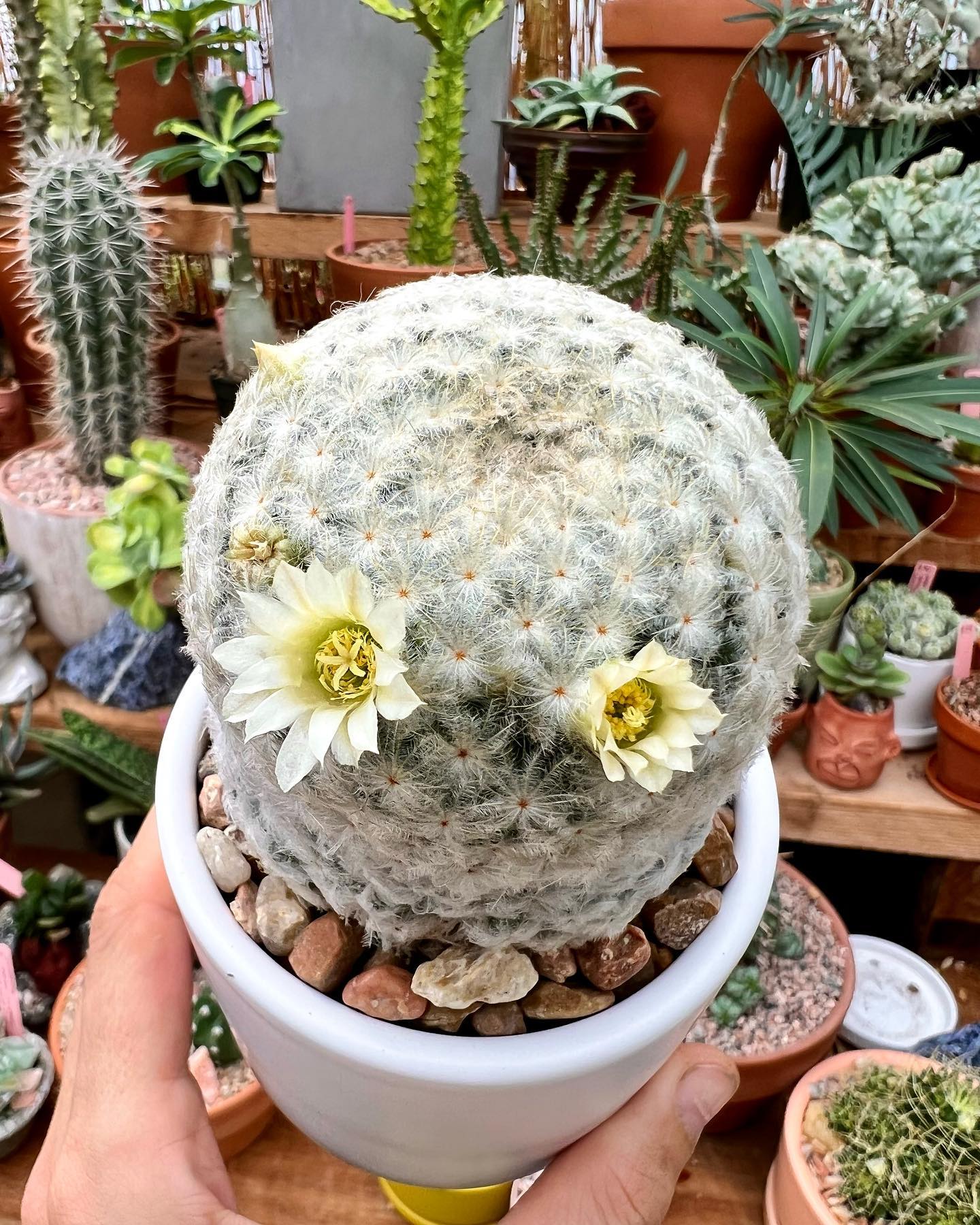Mammillaria plumosa “The gentle and fluffy marvel, Mammillaria plumosa (Feather Cactus).
The fascinating Mammillaria plumosa, often called the Feather Cactus, is a highly sought-after cactus species due to its exquisite, feathery white spines, which give the plant an appearance that is soft and fluffy, almost like a snowball or a cotton ball. This cactus, which has a gentle appearance, is a hardy, drought-tolerant species that is ideal for collectors of all skill levels.
Mammillaria plumosa, a native of the Nuevo León region of northeast Mexico, thrives in dry, rocky habitats and complements the scenery well. A cluster-forming cactus, it generates several offsets, which eventually form a woolly mound of heads.
The Plants
Mammillaria plumosa is the scientific name.
Frequent Names: Feather Cactus, Feather Mammillaria
Family: Cactaceae
Mexico’s Nuevo León is where it originated.
Growth Pattern: Grouping cactus with a low-growing habit
Size:
Individual heads: 2–3 inches (5–8 cm) across
Over time, clumps can grow to be more than 30 cm (12 inches) in diameter.
Spines: Radially arranged, feathery, soft, and white
9 to 11 are the USDA Hardiness Zones.
Blossoms
Bloom Time: late summer to early fall
Look:
Tiny blooms ranging in hue from cream to light yellow
They frequently originate in the space between the woolly spines.
Flowers are around 1 cm in diameter and have a delicate yet alluring appearance.
Make sure the plant has a cold, dry rest period throughout the winter to promote flowering.
Light Needs ☀️
Indoor:
Requires indirect, bright light
A window that faces south or east is perfect.
Refrain from exposing the fragile spines to the midday sun indoors, as it might burn them.
Outside:
Likes filtered light or partial sunshine
Even though it can withstand the morning sun, afternoon shade is advantageous, especially in warmer regions.
The dense feathery covering and compact shape are preserved by adequate light exposure.
🌡️ Temperature and humidity
Ideal Temperature:
The ideal temperature range for growth is 18 to 27°C (65 to 80°F).
If the soil is completely dry, it can withstand temperatures as low as -4°C (25°F) for a short period of time.
Humidity:
favors low humidity
Rot and fungal problems can result from excessive humidity.
In the winter, shield against frost and too much moisture.
💧 Watering Schedule
The Active Growing Season (Spring through Early Fall):
Only give it a good watering after the soil is completely dry.
Although the frequency varies with the environment, it is usually between 10 and 14 days.
Make sure any extra water drains properly.
Winter Dormancy:
Use water sparingly—maybe once every four to six weeks, or not at all if kept cool.
In order to remain healthy and promote blossoming, the cactus requires a dry resting time.
The greatest danger is overwatering since the soft spines may trap moisture, raising the possibility of rotting.
Requirements for soil
Kind:
Requires a succulent or cactus mix that drains effectively
An excellent combination includes:
half cactus soil
coarse sand makes up 25% of the composition.
25% perlite or pumice
pH: between neutral and somewhat acidic
The plant spreads laterally, thus a flat, wide pot with drainage holes is ideal.
🌾 Fertilizer
From Spring to Summer:
Use a diluted cactus fertilizer (e.g., 5-10-10 or balanced 10-10-10) to feed your plants once a month.
Autumn and winter:
Give the plant a break from feeding it.
Excessive fertilization might result in leggy, stunted development.
✂️ Maintenance and upkeep
Not required unless to eliminate:
Flowers that are dead
Rotting or damaged sections
Pest Control: Keep an eye out for:
Mealybugs
Insects that scale
Fungus gnats (if overwatered)
Pests and illnesses are reduced by a dry, well-ventilated environment.
🌿 Reproduction
By Offsets (Pups):
Carefully remove offsets from the mother plant
Give the base a few days to heal over.
Water after a week of planting in dry, well-draining soil.
Using Seeds:
A sterile cactus mixture allows for the planting of seeds on its surface.
Maintain a slightly warm temperature between 20 and 25 degrees Celsius (68 and 77 degrees Fahrenheit) and somewhat moist.
It takes several weeks for seeds to germinate.
Although offsets are faster, collectors may find satisfaction in growing from seeds.
Problems that are Common
Excessive watering: Leads to root rot, which is especially harmful because moisture becomes trapped in the delicate spines.
Low light: may lead to elongation and a loss of compact shape.
Mealybugs are pests that can hide under the delicate spines.
Regularly inspect the base and spines for indications of rot or pests.
🎍 Presentation and Landscaping
Perfect for:
Arrangements that are succulent
Rock gardens
Gardens for dishes
Decorative pots for indoors
It goes nicely with the hard-textured succulents like Lithops or Haworthia because of its soft, snowy appearance.
Conclusion
The Feather Cactus (Mammillaria plumosa) is a lovely, soft-looking cactus that adds texture and curiosity to any collection. It is a low-maintenance, long-lived plant that gives careful caretakers with its delicate blooms and rich clustering development, as long as there is the proper balance of sunlight, little water, and well-draining soil.”
Mammillaria Plumosa
₨799.00
“The tiny, spherical cactus known as the Feather Cactus, or **Mammillaria plumosa**, is indigenous to northeastern Mexico. The whole plant is covered in soft, white, feathery spines, giving it a delicate, fluffy aspect, even though the spines are actually defensive.
This cactus produces gorgeous mounds by growing in little bunches. It needs well-draining, sandy soil and does best in filtered sunlight or bright, indirect light. Similar to most cacti, it is drought-resistant and should be watered sparsely, giving the soil a chance to dry out in between waterings.
Between the fuzzy spines, little white to pale yellow blossoms of the **Mammillaria plumosa** may appear in late summer through autumn. Collectors love it for its distinctive texture and small size, which is ideal for succulent arrangements or indoor displays.”





Reviews
There are no reviews yet.